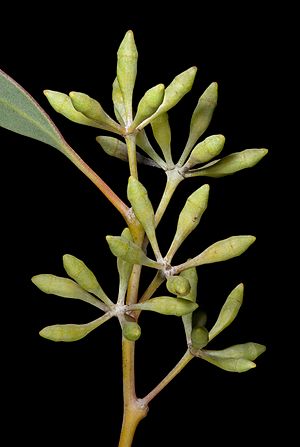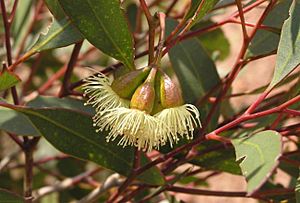Mirret facts for kids
Quick facts for kids Mirret |
|
|---|---|
 |
|
| Eucalyptus celastroides near Coolgardie | |
| Scientific classification | |
| Genus: |
Eucalyptus
|
| Species: |
celastroides
|
Eucalyptus celastroides, often called mirret, is a special type of eucalypt tree. The Noongar people gave it the name mirret. This plant grows only in the south-west part of Western Australia. It is usually a mallee, which means it's a shrub with many stems from the ground. Sometimes, it can grow into a small tree.
Mirret has rough bark on the bottom half of its trunk. The bark higher up is smooth. Its adult leaves are long and narrow, shaped like a spear. The flowers are white and grow in groups of seven or nine buds. After flowering, it produces urn-shaped fruits.
Contents
What Does Mirret Look Like?
Eucalyptus celastroides is mostly a mallee. This means it grows as a shrub with many stems. It can reach a height of about 5 to 8 meters (16 to 26 feet). It also has a special woody swelling at its base called a lignotuber. This helps the plant regrow after fires.
The bark on the lower part of the trunk is rough and flaky. Above that, the bark is smooth and has a mottled whitish color. Young plants and new shoots have bluish-green leaves. These leaves are egg-shaped to oblong. They are about 30-50 mm (1.2-2 inches) long and 12-25 mm (0.5-1 inch) wide.
Adult leaves are green or bluish-green on both sides. They are narrow and spear-shaped. These leaves are typically 65-105 mm (2.5-4 inches) long and 8-15 mm (0.3-0.6 inches) wide. They grow on a stalk called a petiole, which is 8-20 mm (0.3-0.8 inches) long.
Mirret Flowers and Fruit
The flower buds grow in groups of seven or nine. They are on a stalk called a peduncle, which is 4-18 mm (0.15-0.7 inches) long. Each individual bud has a small stalk called a pedicel, about 2-4 mm (0.08-0.16 inches) long.
Mature buds can be club-shaped, pear-shaped, or oval. They are 6-10 mm (0.2-0.4 inches) long and 3-4 mm (0.1-0.16 inches) wide. The top part of the bud, called the operculum, is rounded. It often has a small point at its tip. Mirret flowers are white and bloom between August and January.
After the flowers, the plant produces woody, urn-shaped fruits. These fruits are called capsules. They are 5-8 mm (0.2-0.3 inches) long and 4-8 mm (0.16-0.3 inches) wide. The parts that open to release seeds are tucked inside the fruit.
How Was Mirret Named?
The scientific name for Mirret is Eucalyptus celastroides. It was first officially described in 1852. A scientist named Nikolai Turczaninow gave it this name. He used a plant sample collected by James Drummond. The description was published in a science journal.
The name celastroides comes from another plant genus called Celastrus. The ending -oides is a Latin suffix. It means "likeness" or "similar to". So, celastroides means "like Celastrus".
Different Types of Mirret
In 1986, another scientist named Ian Brooker found two different types, or subspecies, of Eucalyptus celastroides. These types are now officially recognized:
- Eucalyptus celastroides subsp. celastroides: This type has grayish or bluish-green leaves. Its small branches, and sometimes its buds and fruits, have a whitish, powdery coating.
- Eucalyptus celastroides subsp. virella: This type has green leaves. Its branches, buds, and fruits do not have the whitish coating.
Where Does Mirret Grow?
Mirret plants are often found on flat or gently rolling land. They grow well in sandy or clayey soils.
The subspecies celastroides grows more to the east. You can find it in the goldfields region. This area is between Kellerberrin and Norseman. It even extends almost to Balladonia.
The subspecies virella mostly grows in the wheatbelt region. This area is known for farming.




